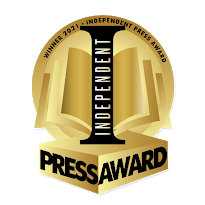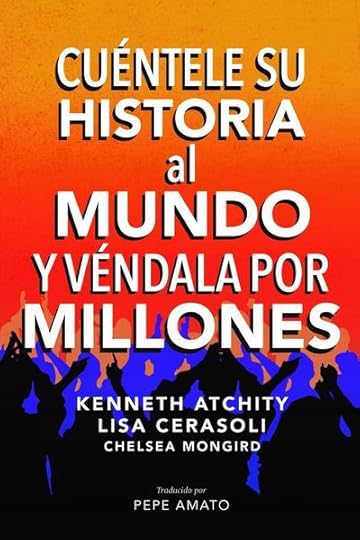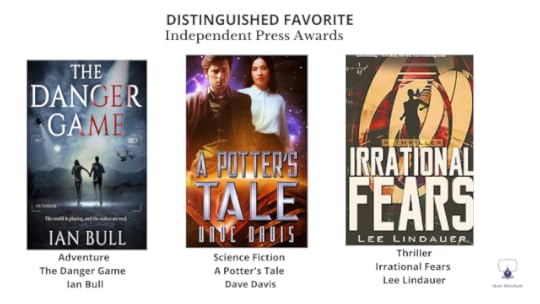Kenneth Atchity's Blog, page 61
May 11, 2021
Dealing with your Type-C Creative Mind – Perseverance
For all storytellers—novelists, screenwriters, journalists, nonfiction writers, and children’s book writers.Learn more about One-on-one coaching to help understand a Type-C personality and equip you with practical tools to make yourself more productive and less frustrated with storytelling.Learn more: http://www.thewriterslifeline.com/
Subscribe to The Story Merchant's YouTube Channel

May 7, 2021
Ken Atchity's "Tell Your Story to the World & Sell It for Millions" Translated into Spanish
May 6, 2021
The Fabulous Cover of the Upcoming Sixth Daniel Rinaldi Thriller, PANIC ATTACK by Dennis Palumbo
A shooter takes deadly aim, and throws a city into panic!

Publishing date is September 21!
Available for pre-order on Amazon NOW!

May 5, 2021
Ben Wheatley on In the Earth and Why He Wanted to Direct The Meg Sequel
During the interview, Wheatley talked about where the idea came from, what it was like filming during a pandemic, what he learned from George Romero interviews about the horror genre, how he wanted to make something in relationship with Kill List and Field in England, how much he debates his opening and closing shots, why he doesn’t like deleted scenes, and more. In addition, he revealed the TV series he’d like to guest direct, his love of Blade Runner, and why he wanted to direct The Meg sequel.
For interviews, movie reviews, and more visit https://collider.com

May 3, 2021
Filmmaker Lila French's Birdbath and Da Parish are on the Louisiana Film Channel!

Birdbath
The film adaptation of Leonard Melfi´s 1965 play
A young, unsuccessful poet meets a young girl while they are both working at an all night cafeteria in Manhattan. It is obvious that she does not want to return home to the Bronx where she lives with her mother, so he convinces her to come to his place. He gets drunk and entices her to drink a little. He tries to seduce her in the mildest manner possible. She resists in the most devastating way imaginable, turning the evening into a nightmare for both of them. It is a boy meets girl love story unlike any other.
Da Parish
In 2005, St. Bernard Parish, a community on the Gulf Coast of Louisiana, was devastated by Hurricane Katrina. Through the personal stories of four long-time residents, we witness their loss, healing and rebuilding, their resilience, and what it is that connects people to the place they call home.
If you'd like to see them along w/ a smorgasbord of other shorts, features, docs, & podcasts in categories like "Louisiana Historicals", "Who do the Voodoo?", and "Films as Scary as The Myrtles Plantation Ghosts", you can sign up for FREE for 6 MONTHS at louisianafilmchannel.com w/ code FRENCHTIKTOK through May 31st.
Lila French Interview for the Louisiana Film Channel.

April 29, 2021
The Meg 2 Starts Filming Next Year
Professional prehistoric shark-puncher, Jason Statham reveals that the sequel to the aquatic monster movie is set to start filming next January.
It's been too long, but the production wheels are finally turning for The Meg 2 , as star and professional prehistoric shark-puncher, Jason Statham, reveals that the sequel to the aquatic monster movie is set to start filming next January.
Steve Weintraub recently spoke with the only man capable of facing a Megalodon with his bare fists about his role in the new Guy Ritchie film, Wrath of Man , but also took the time to ask about Statham's other projects, including the anticipated sequel to The Meg (no? Is it just me? Fine). Not only does Statham confirm he's returning for the sequel, but he also praises Ben Wheatley, who has signed on to return the creature feature.
Wheatley is definitely an odd choice to direct The Meg sequel. Though he's done more action-focused movies like Free Fire , he hasn't really got his hands on a project of this scale before. Still, given the subtle, but still present environmental undertones of The Meg, and its grim and almost satirical tone, it's not impossible to see Wheatley's sensibilities work on megalodon-sized steroids. If you've seen his Sundance movie In the Earth , you know Wheatley is still more than capable of delivering trippy, weird, and scary environmental thrills, and Statham seems to be on board, so we can't help but follow him.
You've heard the man. There is a good chance that The Meg 2 turns out good, and judging by how fun the first Meg was, I can't wait to see someone like Wheatley inject his sensibilities into the project. Just make sure Statham punches another shark in the face and we're golden!
Read more

April 27, 2021
Dealing With Your Type-C Personality: Time and Work
Learn more about One-on-one coaching to help understand a Type-C personality and equip you with practical tools to make yourself more productive and less frustrated with storytelling.Learn more at www.thewriterslifeline.com

April 23, 2021
Congratulations to Story Merchant Books Winning Authors!


THE 2021 INDEPENDENT PRESS AWARDS
ACKNOWLEDGES NINE STORY MERCHANTBOOKS AUTHORS WITH AWARDS
LOS ANGELES, CA—Story Merchant is proud to announce the 2021 Independent Press Awards acknowledges nine of our authors, both those represented by Story Merchant or published through our imprint, Story Merchant Books.
Congratulations to the following Story Merchant authors for these awards:
444 Days: Memoirs of a Hostage Wife by Marge German; Winner in the MEMOIR category
The Bronx Stagger by Daniel P. Moskowitz; Winner in the CROSS-GENRE category
***
The Danger Game by Ian Bull; Distinguished Favorite in the ACTION/ADVENTURE category
The Gift from Fortuny by Terry Stanfill; Distinguished Favorite in the WOMEN’S FICTION category
Grizzly Justiceby April Christofferson Distinguished Favorite in the WESTERN FICTION category
Inside the Lie by Gary Wenkle Smith; Distinguished Favorite in the CRIME FICTION category
Irrational Fearsby Lee Lindauer; Distinguished Favorite in the THRILLER category
Japanese In-Law: Words and Phrases for Day-to-Day Living by Kenneth Atchity and Keisaku Mitsumatsu; Distinguished Favorite in the REFERENCE category
A Potter's Tale by Dave Davis; Distinguished Favorite in the SCIENCE FICTION category
The INDEPENDENT PRESS AWARDrecognizes over 200 Book Award Winners and Distinguished Favorites in its annual book competition. The competition is judged by experts from different aspects of the book industry, including publishers, writers, editors, book cover designers and professional copywriters. Selected award winners and distinguished favorites are based on overall excellence.
In 2021, the INDEPENDENT PRESS AWARD had entries worldwide. Participating authors and publishers reside in countries such as Australia, Canada, India, Ireland, Japan, Singapore, Switzerland, United Kingdom, and others. In addition, books submitted included writers located in U.S. cities such as Atlanta to Santa Fe; Chicago to New York; from Boise to Honolulu, and others.
"We congratulate this year's 2021 winners and distinguished favorites in the annual INDEPENDENT PRESS AWARD. The quality and quantity of excellent independently published books hit a record. Independents recognized are thriving around the globe. We are so proud to announce these key titles representing global independent publishing." said awards sponsor Gabrielle Olczak.
For more information, please visit independentpressaward.com; and to see this year's list of IPA Winners and Distinguished Favorites, please visit the website pages:
2021 WINNERS:
https://www.independentpressaward.com/2021winners
2021 DISTINGUISHED FAVORITES:
https://www.independentpressaward.com/2021distinguishedfavorites
Story Merchant – representing stories to traditional publishing as well as to Film and TV in Hollywood
Story Merchant Books – Direct-publishing new voices
To request a review copy or inquire about an author interview, please email atchity@storymerchant.com

April 19, 2021
Congratulations to Story Merchant Books Winning Authors in this Year's Independent Press Awards
April 15, 2021
Director Ben Wheatley says that The Meg 2 might live up to its title in more ways than one.

The Meg 2 is a thing. Three years after the release of the original The Meg, which swallowed up an astonishing $530 million worldwide at the box office, director Ben Wheatley — fresh off his eerie new horror film In The Earth — is deep in pre-production on a sequel to the 2018 thriller that pitted puny humans against a couple of oversized prehistoric sharks.
“I’m storyboarding at the moment on Meg 2,” Wheatley says when we catch up with him for the release of In The Earth. “It’s been going on for four months, five months. It’s my happy place, I love storyboarding. So yeah, I’m cutting storyboards and watching animatics, and slowly constructing the movie. It’s really exciting. It’s just action on a massive, massive scale.”
The first film, based on the popular 1997 novel Meg by Steve Alten, reached the screen in 2018 after more than two decades of development. The property bounced from Disney to New Line Cinema, to Warner Bros., with directors like Jan de Bont (Speed) and Eli Roth (Hostel) attached at various points. Cameras finally rolled in 2016 with Jon Turteltaub (National Treasure) directing from a script by Dean Georgaris and Jon and Erich Hoeber.
The latter pair have apparently returned to pen the sequel, which Wheatley says he has had no hand in writing: “No, the script is by the Hoeber brothers that wrote the first script, so it’s kind of a continuation on from that story.”
As for whether the cast members who survived the first film — which included British action star Jason Statham, Chinese actress Li Bingbing and a handful of others — will also encore in the follow-up, Wheatley is somewhat cagier, although he does drop a tantalizing hint about the title menace. “I don’t think I can say at the moment what’s going on, the ins and outs of it,” he intones. “But guaranteed, there will be a Megalodon — maybe more than one.”
While the prospect of even more Megalodons wreaking havoc in the sequel, which is provisionally called The Meg 2: The Trench, is an exciting one, it’s all but guaranteed that Statham, who is said to be “creatively involved” with the project, will be there punching them as well.
Alten’s novel was altered significantly for the screen, becoming less of a grisly horror shocker and more of a Statham action joint. It’s worth noting that Alten’s own sequel to his novel Meg was also called The Trench, although we don’t expect a faithful adaptation this time either.
The first film’s self-awareness and somewhat jokey tone, coupled with Statham’s own dryly humorous charisma, turned The Meg into a relative rarity: a monster movie that was both fun and not afraid to poke fun at itself. That was enough to lure in those massive audiences and set the wheels of a sequel in motion.
Although Wheatley’s last outing was Netflix’s glossy adaptation of the Daphne du Maurier novel Rebecca — a bold choice since it was previously filmed by Alfred Hitchcock — he’s perhaps best known for his razor-sharp combinations of horror, crime and satire in films like Kill List, Sightseers and Free Fire. If he manages to retain the tone set by the first Meg while adding his personal touch to the proceedings, this could end up being a sequel with, dare we say it, real teeth.
As for going from the high-end esthetics of Rebecca to the guerilla filmmaking of In The Earth (more on that to come) to the presumably explosive, effects-driven action of The Meg 2, Wheatley puts it simply: “I think that’s always the hope, that they’re different [from each other]. You don’t want to end up making the same thing again and again.”
Read more

Written by
Don Kaye | @donkaye
Don Kaye is an entertainment journalist by trade and geek by natural design. Born in New York City, currently ensconced in Los Angeles, his earliest childhood memory is…










